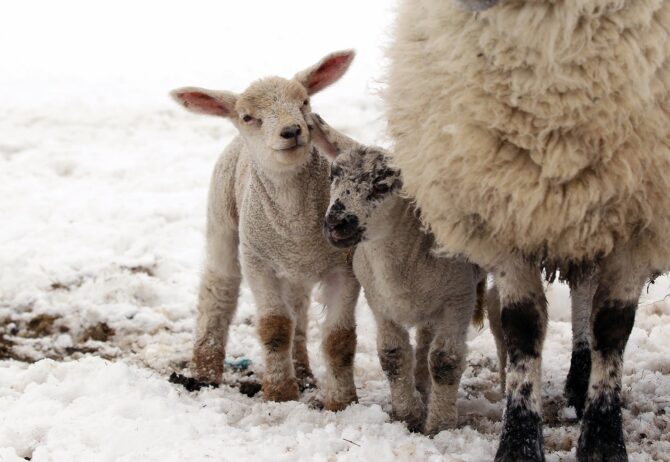Raising chickens requires a keen understanding of their needs, especially when it comes to their living environment. One crucial aspect is maintaining the ideal temperature for them to ensure their health, productivity, and well-being.
In this comprehensive guide, we will explore the appropriate temperatures for chickens and provide valuable insights to help both novice and experienced poultry keepers ensure the perfect conditions.
Ideal Temperature Ranges
Identifying the ideal temperature range for chickens is pivotal for their well-being. Different breeds have varying tolerances, and age also plays a significant role in how chickens cope with temperature fluctuations.
Requirements for Different Breeds

Different chicken breeds have varying temperature tolerances. For instance, heavier breeds like the Jersey Giant are more resilient to cold temperatures due to their larger body mass and denser feathering.
They can maintain their body temperature more efficiently in colder climates, making them suitable for regions with harsh winters. Conversely, lighter breeds like the Leghorn are better suited to warmer climates.
They have a higher tolerance for heat and are more adept at staying cool in higher temperatures. Understanding the specific requirements of each breed is essential for providing the right environment and ensuring the health and productivity of the flock.
| Chicken Breed | Ideal Temperature Range (°F) | Notes |
|---|---|---|
| Jersey Giant | 20 – 75 | Heavier and well-insulated, better suited for colder climates. |
| Leghorn | 45 – 85 | Lighter and well-ventilated, better suited for warmer climates. |
| Rhode Island Red | 25 – 75 | Hardy and adaptable, suitable for a wide range of temperatures. |
| Plymouth Rock | 30 – 75 | Versatile and robust, can adapt to varying climates. |
| Silkie | 45 – 75 | Prefer milder temperatures, need protection from extreme cold and heat. |
| Orpington | 20 – 75 | Heavy and well-feathered, good for colder climates. |
| Sussex | 25 – 75 | Adaptable and resilient, suitable for varying temperatures. |
| Wyandotte | 20 – 75 | Hardy and well-insulated, good for colder climates. |
Age-Related Temperature Sensitivity
Chickens’ temperature sensitivity varies significantly with age. Chicks, being extremely sensitive to fluctuations, require a consistently warm environment to thrive.
Initially, they need a temperature of around 95°F, which should be gradually decreased by 5°F each week until they are fully feathered. This careful regulation is crucial for the development and survival of young chickens.
Mature chickens, on the other hand, are more resilient to variations. They typically thrive in temperatures between 45°F and 75°F.
However, sudden and extreme changes can still be stressful, so it’s important to monitor environmental conditions closely and make adjustments as needed to maintain optimal health and productivity.
Creating the Optimal Environment
Creating an environment that meets the chickens’ needs is crucial. This involves considering housing, ventilation, and access to water and food.
The Importance of Proper Housing
Proper housing is a cornerstone in maintaining the ideal temperature for chickens. It provides shelter from the elements, protects against predators, and offers a controlled environment where temperature, humidity, and ventilation can be managed effectively.
A well-designed coop should be insulated to maintain a consistent temperature and equipped with adequate ventilation to prevent moisture buildup and allow fresh air circulation.
In addition to insulation and ventilation, the coop should be kept dry and clean to prevent the growth of harmful bacteria and parasites. Bedding materials like straw or wood shavings can help absorb moisture and provide additional insulation.
Regular cleaning and maintenance are essential to ensure a healthy and comfortable living environment for the chickens.
Ventilation and Temperature Control
Ventilation is crucial in maintaining the perfect temperature within the chicken coop. It allows fresh air to circulate, removes excess moisture, and helps in regulating the temperature.
Properly placed vents or windows can facilitate airflow and prevent the accumulation of ammonia from chicken waste, which can be harmful to both chickens and humans. However, it’s important to balance ventilation with insulation.
Too much ventilation can lead to drafts, which can be detrimental in cold weather. Conversely, inadequate ventilation can result in overheating during warmer months.
Striking the right balance is key to ensuring the well-being of the flock and maintaining optimal egg production and growth.
Weather Changes and Chickens
Weather changes can have a profound impact on chickens, affecting their behavior, health, and productivity. It is crucial to understand how different weather conditions can affect chickens and what measures can be taken to mitigate these effects.
Adapting to Seasonal Variations

Seasonal variations bring about changes in temperature, humidity, and daylight, all of which can affect chickens.
During winter, the drop in temperature and reduced daylight hours can lead to decreased egg production and increased food consumption as chickens expend more energy to stay warm.
Providing supplemental lighting and ensuring adequate food supply are essential during this period to maintain productivity. Summer, with its elevated temperatures, poses the risk of heat stress.
Ensuring access to clean, fresh water and providing shade are crucial during this time.
Implementing cooling measures like fans or misting systems can also help in maintaining a comfortable temperature within the coop and preventing heat-related illnesses.
Managing Extreme Weather Conditions
Extreme weather conditions such as heatwaves, cold snaps, and storms can be particularly challenging. In such situations, it is crucial to take immediate action to protect the flock.
During extreme cold, additional heating may be required to prevent frostbite and hypothermia, and extra bedding can provide additional insulation.
In contrast, during extreme heat, it is vital to keep the chickens well-hydrated and to employ additional cooling measures. Providing electrolytes can help chickens maintain balance and recover from heat stress.
Being prepared and having a plan in place for such extreme conditions can be a lifesaver for your flock.
Nutritional Adjustments for Temperature Fluctuations
Nutrition plays a pivotal role in helping chickens cope with temperature fluctuations. Adjusting the diet according to the weather can help in maintaining health and productivity.
| Season | Nutritional Needs | Additional Requirements | Notes |
|---|---|---|---|
| Winter | High in energy and protein | Continuous supply of water, vitamins, minerals, and grit | Focus on maintaining body weight and egg production. Monitor water intake as chickens may consume less water if it is too cold. |
| Summer | Reduced protein content, fresh greens, and fruits | Fresh, cool water with electrolytes, shade, and cool areas | Focus on hydration and maintaining electrolyte balance to prevent heat stress. Monitor for signs of heat stress and make immediate adjustments. |
FAQs:
Can chickens tolerate snow and freezing temperatures?
Yes, many breeds can tolerate snow and freezing temperatures as long as they are provided with a well-insulated coop to protect them from the elements.
However, extra care, such as providing additional heat sources and ensuring that water sources do not freeze, is necessary to maintain their well-being during extremely cold weather.
How can I monitor the temperature in my chicken coop effectively?
Utilizing a reliable thermometer within the coop can help in monitoring the temperature effectively.
Additionally, modern technology offers remote temperature monitoring systems, allowing poultry keepers to check the coop’s temperature via smartphone apps, ensuring that any fluctuations are addressed promptly.
Do chickens need a heat lamp during winter?
While chickens are quite resilient and can adapt to colder temperatures, in extremely cold climates, a heat lamp may be necessary to prevent frostbite and other cold-related issues.
However, it’s crucial to use heat lamps safely to avoid fire hazards and to monitor the temperature closely to prevent overheating.
How do I know if my chickens are experiencing heat stress?
Chickens experiencing heat stress may exhibit signs such as panting, spreading their wings away from their bodies, lethargy, and a decrease in feed intake and egg production.
Immediate intervention, like providing cool water, shade, and proper ventilation, is crucial to alleviate heat stress.
Can chickens get frostbite?
Yes, chickens can get frostbite, especially on their combs, wattles, and toes, in extremely cold conditions.
Providing a well-insulated and draft-free coop, applying petroleum jelly to combs and wattles, and using proper bedding can help in preventing frostbite during freezing temperatures.
Summary
By implementing the insights and strategies discussed, poultry keepers can create a conducive and harmonious environment, ensuring the flock’s health, happiness, and productivity, regardless of external conditions.
Acknowledgment of the varying needs of different breeds and ages, and implementation of proper housing and environmental controls, poultry keepers can ensure the health, well-being, and productivity of their flock.






